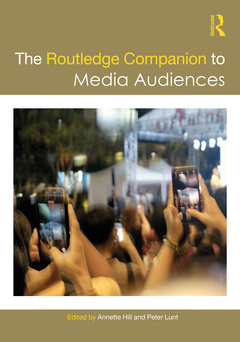Description
The Routledge Companion to Media Audiences
Routledge Media and Cultural Studies Companions Series
Coordinators: Hill Annette, Lunt Peter
Language: English
Subjects for The Routledge Companion to Media Audiences:
· 17.4x24.6 cm · Hardback
Description
/li>Contents
/li>Readership
/li>Biography
/li>
The Routledge Companion to Media Audiences captures the ways in which audiences and audience researchers are adapting to emerging social, cultural, market, technical and environmental conditions.
Bringing together forty original essays, this anthology explores how our constantly changing encounters with media are complex, contradictory, and increasingly commercialized in the modern world. Each specially commissioned chapter by both early career and experienced international scholars, surveys new conceptualisations and constitutions of audiences, and assesses key issues, themes, and developments within the field. As such, this companion cements itself as an indispensable guide for students and researchers who seek a comprehensive overview and source of inspiration for a diverse range of topics in media audiences.
The Routledge Companion to Media Audiences is an accessible, landmark tool which enhances our understanding of how media is utilised through advanced empirical research and methodological enquiry. It is a must-read for media studies, communication studies, cultural studies, humanities and social science scholars and students.
Introduction to Companion to Media Audiences PART I: AUDIENCE THEORIES AND APPROACHES Introduction 1. Constituting the Techno-Normal: The Practices of Everyday Media Consumption 2. Mediations, Popular Cultures, and Cartographies: Contemporary Audiences in Latin America 3. Media Audiences as Explorers of Interpretant Signs and Vulnerable Frames 4. How Universalised Language Misconstrues Audiences in the “Middle East” 5. De-westernizing Fan Studies in the Era of Globalization and Digitization 6. Media-Ready Feminism, Everyday Sexism, and Audience Reception: Negotiating the Entanglements of Polysemic Televisual Texts 7. From Media Audiences to Everyday Cultures and from Signifying Practice to Practical Sense PART II: AUDIENCE IMAGINARIES Introduction 8. Broadening the Imagined Audience: The Case of “Gamers” 9. Platformisation and Personalisation: The making of “contingent” online audiences 10. Imagining Audiences as Media Users: Audience Research’s Role as an Imagining Institution 11. Relationship Status of Journalists with Their Audiences on Social Media: It’s Complicated 12. Allies or Antagonists? Reconciling Engaged Journalism’s Imagined Audiences 13. When TV Shows Get More Inclusive, Yet Audiences More Divided: How to Study Fan and Anti-Fan Communities Online PART III: AUDIENCE MODES Introduction - Audience Modes: A Granular Approach 14. Transmedia (Anti-storytelling) Audiences 15. Virtual (Idol) Audiences: Canon, Fanon and Multivocality in Vocaloid Cultures 16. Immersive Audiences: Dreaming Of Living in Media 17. Streaming Audiences: Deconstruction of Fashion Gender Stereotypes Through the Imitation of TV Series Outfits 18. Reactive Audiences: Carnal Videos 19. Bored Audiences: Zoned In and Out PART IV: AUDIENCE ENGAGEMENT AND EXPERIENCES Introduction 20. Tracking Engagement in Documentary Viewing: A Critical Retrospect 21. When Does Documentary Cut Through? The Challenge of Tracing Documentary’s Social and Political Impact Through Audience Research 22. Playing the Audience Card 23. Rethinking Transmedia Audiences 24. Social Movements and the Self-mediation of Vulnerability on Digital Media PART V: AUDIENCES, AFFECT AND IDENTITIES Introduction 25. ‘I Know What You Mean’. Contingency and Contextualisation: Subjects, Technology and Affect in Everyday Practice 26. Unwanted Audienceship, Audience Resilience: A Case Study of the MIRROR Incident in Hong Kong 27. Black Audiences, Brand Voices, and Affective Communities 28. What’s Labour Got to Do with It? Getting (Back) To Class and Culture in Audience Research 29. Intimate Orientations: People’s Everyday Engagements with Digital Media PART VI: AUDIENCE PLACES AND ENVIRONMENTS Introduction 30. Affective Infrastructuring as a Survival Mechanism: Unhoused Media Users and Their Media 31. Geometries of Power and Latin American Feminist Audiences 32. Neuroqueering Audience Research 33. Slow Affect: Chinese slow reality television and COVID cultures of viewing 34. The Felt Experience of Atmosphere: Implications for Audience Research PART VII: METHODOLOGIES FOR THE STUDY OF MEDIA AUDIENCES Introduction 35. Rethinking The Methodologies of Media Effects: Introducing Quantitative Criticalism 36. Audience Research in a Cross-Cultural Framework: When Lofty Ideals Collide with Complicated Realities 37. Interviewing as Building Situated Platform Knowledge: A Reflection on Interviews with Transnational Women Content Creators 38. Digital Bayanihan as Method: Rethinking the Audience-Producer Relationship in Influencer Cultures 39. Youth Participatory Action Research: Methods and the study of audiences 40. Integrating Autoethnography and Interviewing for Researching Child and Parent Audiences in Turkey
Annette Hill is Professor in Media and Communication, Jönköping University, Sweden. With 25 years’ experience of audience research, in over 100 publications, her work addresses transnational audiences for factual and fictional genres, live events, tourism and theatre, using multi methods and analytic dialogue with industry and citizen stakeholders.
Peter Lunt is Professor of Media and Communication at the University of Leicester, UK. His research encompasses audience research, media regulation and the relationship between media research and social theory.




